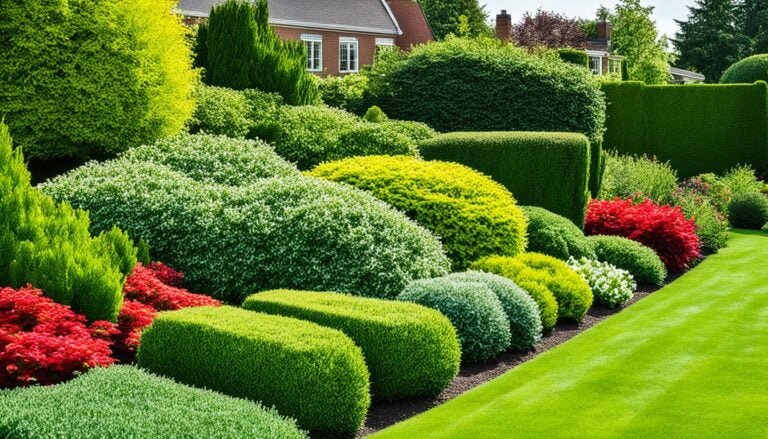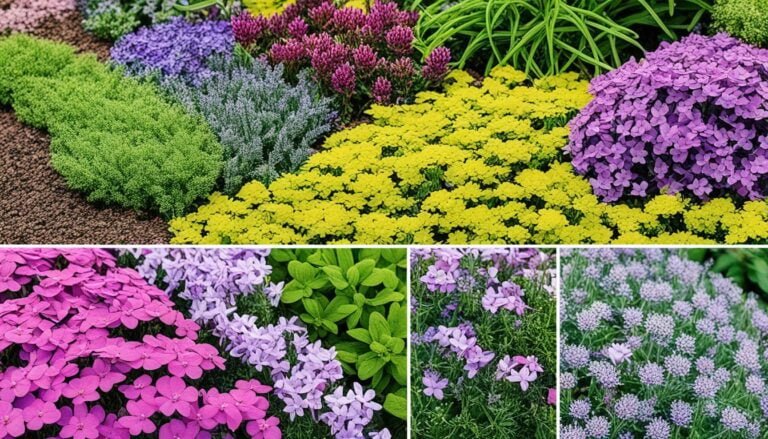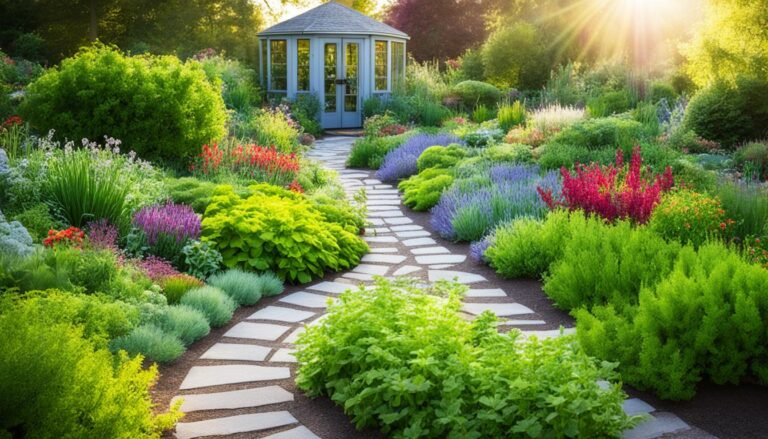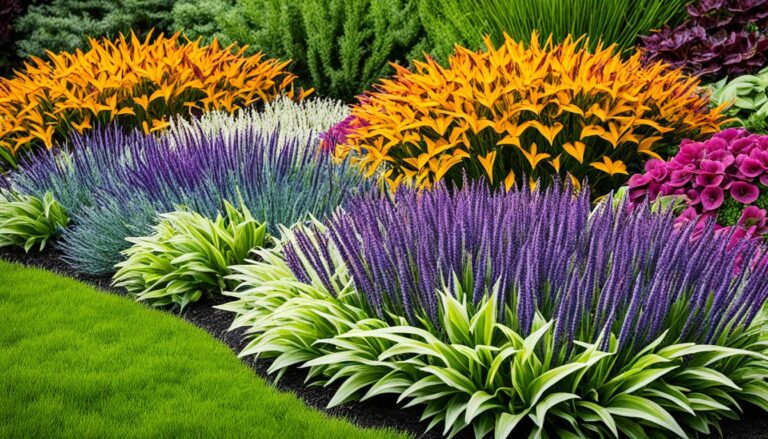Enjoy making your colorful flower garden oasis. It’s a place to feel close to nature and show your unique style. A colorful flower garden includes bright annuals, perennials, and peaceful shrubs or trees. This mix makes a beautiful floral scene. It’s key to share helpful and good-looking gardening methods. These tips mix beauty with practicality.
evidence shows 70% of traditional homes suit cottage-style gardens. For modern homes, focusing on flower shapes and colors helps 60% look better. When planning your garden, start small. You can always add more later. Too much at first can make it hard for some plants to thrive. Strategic planting lets every plant get sunlight they need. Use odd numbers of plants for better looks. Also, putting down at least an inch of mulch after watering helps keep the ground moist and cuts back on water use.
Key Takeaways
- Traditional homes often look best with a cottage-style garden.
- Flower bed shape and color selection enhance contemporary homes.
- Start small and expand your garden over time.
- Ensure shorter plants are not shaded by taller neighbors.
- Plant in odd numbers for a visually appealing arrangement.
- Apply at least an inch of organic mulch to help retain moisture.
Choosing the Right Location for Your Flower Garden
An ideal spot for your flower garden design is crucial. Where you plant greatly affects the health and look of your flowers. It’s important to check how much sunlight and what type of soil your garden spot needs. This way, your flowers will be vibrant and make your outdoor space beautiful.
Sunlight Requirements
Knowing the sunlight needs of your plants is key. Plants like lilies and dahlias need lots of sun, about six hours a day. In comparison, flowers like asters and foxglove do better with less sun. When you plan your garden, aim for a good mix of sun and shade. This mix helps all your flowers bloom brightly.
| Plant Type | Sunlight Needs | Examples |
|---|---|---|
| Full Sun | 6+ hours/day | Lilies, Dahlias |
| Partial Shade | 3-6 hours/day | Asters, Foxglove |
| Full Shade | Ferns, Hostas |
Accessibility and Visibility
A garden that’s easy to get to is also easy to take care of. It should be placed somewhere you can see from your home. This not only makes your home nicer for you but also for guests. Whether it’s a big or small garden, ease of access and good visibility make for a great flower garden design.
The garden’s location next to water sources and toolsheds should also be considered. It’s about finding a balance between what’s practical and what looks nice. Adding things like pergolas and arbors can help. They provide support and look great without taking away from your plants.
Understanding Your Soil Type
Knowing your soil is key for garden lovers wanting a bright, colorful garden. Learning about the soil types and how to improve them boosts your gardening success.
Testing Your Soil
The first step in soil care is testing it. A basic pH strip shows if your soil is too acidic or too alkaline. Mix a sample of soil with water. Check that the pH level is close to 6.5. This is good for plants. If not, you may need to adjust the soil. Soils can be sandy, clay, loamy, peaty, silty, or chalky. Each type has its own traits.
To have the best soil, think about it like this: 50% sand, 25% silt, and 25% clay. You can tell what your soil is like by how fast it settles in water. Sand goes down quickly, silt takes a few hours, and clay takes the longest.
Amending Your Soil
Improving soil helps your plants grow better. Sandy soil needs more nutrients and moisture. Clay soil needs better drainage. Add fertilizers or organic material to fix these issues. Each soil type needs different care to have a colorful, thriving garden.
| Soil Type | pH | Characteristics | Improvement Tips |
|---|---|---|---|
| Chalky | 7.1 – 8.0 | Alkaline, stony, free-draining | Use acidic fertilizers |
| Clay | Varies | Slow to warm, poorly drained, nutrient-rich | Add organic matter, compost |
| Loamy | 6.0 – 7.0 | Easy to work, well-drained, nutrient-rich | Maintain with organic matter |
| Peaty | Below 7.0 | Acidic, high organic content, water-retentive | Improve drainage with lime, compost |
| Sandy | 5.5 – 7.0 | Free-draining, warms quickly, nutrient-poor | Add mulching, organic fertilizers |
| Silty | 6.0 – 7.0 | Free-draining, retains moisture, fertile | Enhance with organic matter |
By using these tips, you can make your garden beautiful and healthy all year. Practice colorful gardening, test your soil, and improve it. These basics lead to a successful garden.
Designing Your Garden Layout
When you design your garden, let your creativity flow. You can go for structured formal gardens or the free-spirited cottage gardens. Each choice has its own special charm. Below, we dive into what makes each type special.
Formal Gardens
Formal gardens lean on symmetry and order. They boast stunning flower bed arrangements. Every plant plays a part in a beautifully balanced theme. Here’s what to include:
- Well-defined geometric shapes
- Neatly trimmed hedges and topiaries
- Breathtaking focal points like fountains or statues
For the perfect formal look, think about how tall and wide plants will get. To keep it interesting year-round, mix up when plants bloom and their textures. Add structures like pergolas to take your garden to the next level.
Cottage Gardens
Cottage gardens are laid-back and full of life. They mix various flowers, from perennials to ornamental grasses. Here’s what to aim for:
- Mix-and-match approach with diverse plant varieties
- Informal planting schemes with an intentional “wild” look
- Attract it with bees, butterflies, and other pollinators
When you make a cottage garden, focus on blending colors and use the same plants throughout. A focal point, like a bench, adds a nice touch. Make sure the bed is ready before planting by cleaning up, adding compost, and creating paths.
Armed with these ideas, you can create a garden that’s a reflection of you. Choose from the refined formal gardens or the magical cottage gardens.
Selecting the Right Plants
When you want a garden full of color, what you plant matters a lot. You need to think about the weather and how much sun your garden gets. This helps ensure your plants will grow well.
Climate Considerations
Knowing your area’s climate is key for plant selection. It’s crucial to pick plants that survive your winter. Molly E. Williams says, “Plants needing full sun can’t live in the shade. And those for shade won’t do well under intense sun.” So, it’s vital to choose plants that match your area’s conditions.
Sunlight and Soil Requirements
Plants need the right amount of sunlight to thrive. Jim Putnam advises mixing different types of plants to boost how many blooms you get. Barbara Shea mentions that plants also need specific kinds of soil and nutrients. To make sure your plants do their best, match them with the right amount of light and prep the soil as needed.
Molly E. Williams also recommends placing flowers and shrubs strategically in your yard. This can help in making eye-sores, like electric boxes, less noticeable. Paying attention to such details can lead to a garden full of beautiful flowers.
Creating a Colorful Flower Garden
When you design a beautiful flower garden, you bring together a wide range of colorful plants. These plants do more than just look pretty. They help the environment and feed local animals.
Colorful gardens can even survive hot and dry weather. They attract important pollinators like butterflies and bees. A color wheel is a helpful tool for choosing which flowers to plant.
As you pick flowers, think about using all kinds of colors. Mix warm reds with cool blues. This way, your garden will have exciting colors all year.
Using design elements makes your garden look more complete and beautiful. Mixing plants of different heights and textures creates a rich landscape. Hanging baskets add color to places that can’t have plants in the ground.
Keeping your garden bright and colorful takes work. You need to be dedicated, patient, and plan carefully. By choosing the right flowers and designs, your garden can look great all the time.
No matter the style of your garden, the goal is the same. You want harmony in every part. Picking the right plants and colors ensures your garden stays inviting and well put-together.
| Element | Details |
|---|---|
| Choice of Plants | Annuals, perennials, tropicals |
| Color Schemes | Using color wheel strategies |
| Pollinator Attraction | Butterflies, birds, bees |
| Garden Designs | Cottage gardens, formal gardens |
A garden full of colorful blooms is not just nice to look at. It also promotes life and shows who you are. It’s a space that invites people in and supports plants and critters.
Incorporating Perennials for Year-Round Beauty
Creating a perennial garden means your garden will always look good. These plants come back every year. By mixing different perennials, your garden can be beautiful all year. Choose plants that bloom in the spring, summer, and fall, and some that look great in the winter.
Popular Perennial Choices
Perennials like daylilies, hostas, and coneflowers are very popular because they’re tough and beautiful. Let’s check out other favorites that make gardens shine:
- Coneflower (Echinacea): Hardy in Zone 3 to 9, reaching 2 to 5 feet with daisy-like blooms.
- Bluestar (Amsonia): It blooms in May and June, with narrow leaves on 2 to 3-foot stems.
- Barrenwort (Epimedium): Loves Zones 4 to 8, growing 5 to 24 inches tall and spreading up to 3 feet wide.
- Sedum (Sedum): Does well in Zones 3 to 9, changing to yellow, orange, or red in late fall.
- Japanese Silver Grass (Miscanthus sinensis): Gets 3 to 12 feet tall with golden-beige fall foliage.
- Siberian Iris (Iris sibirica): Blooms late spring to early summer, up to 36 inches tall.
- Candytuft (Iberis): A groundcover, growing 6 to 18 inches tall and wide.
- Creeping Phlox (Phlox subulata): Reaches 2 to 6 inches, spreading 12 to 20 inches with colorful flowers.
- Bergenia (Bergenia): Shows purplish-pink to white flowers from 12-inch stems in spring.
- Perennial Geranium (Geranium): Different types reach about 18 inches tall, spreading 24 inches wide.
Getting the right mix of popular perennial choices makes your garden beautiful all the time. Listen to experts, pick plants that suit your area and bloom at different times, and keep up with garden care. This way, you’ll have a lovely, lively place outside.
Adding Annuals for Seasonal Color
Adding annuals to your garden keeps it lively all year. They come in many colors and textures. This changes your garden into a beautiful place.
Benefits of Annuals
Annuals don’t just look pretty. They bloom from summer to fall. This makes your garden bright for months. They also grow fast, some up to six feet, adding strong shapes.
You can have fun with annuals. Places that sell unique ones help you stand out. For example, ‘Profusion Apricot’ zinnias and ‘Violet Queen’ spider flowers are unique favorites. They add special colors and shapes to your garden.
It’s important to care for your annuals well. Water, feed, and prune them for the best results. Also, removing old flowers helps them bloom again. Keep up with water, food, mulch, and they will do great all season.
If you want to keep your rare plants through winter, you can. Some should come inside to survive. Make sure they get the right light and care until it’s time to plant again.
| Tip | Details |
|---|---|
| Height and Vertical Elements | Use stakes for tall plants like sunflowers and cosmos to add dimension and prevent toppling. |
| Regular Care | Ensure consistent watering and fertilizing during dry spells and growing phases. |
| Mix of Plants | Combine both tender and hardy plants for a varied and durable garden composition. |
| Tracking Growth | Maintain a gardening journal to monitor bloom times and seasonal events for optimal garden planning. |
Blooms Greenhouse has been helping with great gardens for over 35 years. They offer many types of annual flowers. Mixing annuals with perennials means your garden blooms all the time, making it lively and exciting always.
Maximizing Sunlight and Hydration
To make a flower garden thrive, it needs sunlight and plenty of water. Put your plants where they’ll get the light they need. And water them the right way to keep them healthy through the year.
Proper Placement
Sunlight is key. Place your flowers where they can get the light they need. Use a mix of plants like perennials and annuals to create a beautiful space. Know if your plants need full sun or just a bit to grow their best. This helps you arrange your garden beds well. Make sure there’s a focal point for each bed. Consider how tall and big your plants will get. Good placement means a healthier, more colorful garden. Also, consider adding structures like pergolas to control sunlight levels.
Watering Tips
Your garden must be well-watered for bright, healthy blossoms. Before planting, add compost to make the soil better at holding water. Then, water your garden like this:
- Deep, Infrequent Watering: Water deeply but not too often to help roots grow strong. This makes plants tougher when it’s dry.
- Timing: Water in the morning or evening to lose less to evaporation. It saves water and helps your garden more.
- Mulch: Put mulch on the soil to keep it moist, stop weeds, and make your plants healthier.
By watering right and picking sunny spots for your plants, your garden will be amazing. Think about when your flowers will bloom. Plant different flowers to keep your garden looking great all year. You can learn more about designing a successful garden here.
| Gardening Tips | Benefits |
|---|---|
| Maximize Sunlight | Encourages optimal plant growth |
| Deep, Infrequent Watering | Promotes strong root systems |
| Morning/Evening Watering | Reduces evaporation |
| Mulching | Maintains soil moisture |
Pruning and Maintenance
Keeping a flower garden beautiful means taking care of it often. When you prune, you make sure the plants get enough air and grow strong. This kind of work helps your garden shine all year round.
Regular Pruning
Pruning flowers and shrubs regularly is vital. It keeps your garden looking nice and your plants healthy. For example, catmint can be cut down to keep making flowers. After frost, Veronicas should be trimmed close to the ground.
Keeping woody salvias clean by removing old flowers helps them keep blooming. And cutting back peonies after frost can stop fungus. German irises do well with a good trim in August to avoid fungal issues.
Pest Control and Fertilization
Dealing with bugs and adding the right nutrients are key to a lively garden. Good pest control means getting rid of bad bugs without hurting the good ones. You could use safe sprays or bug-eating animals to keep your flowers safe.
Feeding your plants helps them stay full of life and bloom a lot. Checking your soil and using the right kind of food is smart. Natural fertilizers make the soil better slowly, helping your garden for a long time. But sometimes, using food made in a lab gives your plants exactly what they need. Just use it carefully to not give your plants too much.
| Flower | Pruning Time | Pest Control | Fertilization |
|---|---|---|---|
| Catmint | Anytime | Regular Monitoring | Organic (Compost) |
| Veronicas | After Hard Frost | Natural Repellents | Synthetic (Balanced Ratios) |
| Woody Salvias | Throughout Season | Biological Controls | Organic (Compost) |
| Peonies | Post Hard Frost | Regular Monitoring | Synthetic (Balanced Ratios) |
| German Irises | August | Natural Repellents | Organic(C compost) |
Enhancing Your Garden with Shrubs and Trees
Adding shrubs and trees to your garden makes it look better. It adds both structure and depth, making your landscape beautiful all year. It’s about picking the right ones for the soil and climate.
Layering Techniques
The layering garden design is a smart way to make your garden more interesting. You set plants by their heights to create layers. Shrub selection for Zones 2-11 is key here.
Having a mix of shrubs at different heights is the secret to a great layered look. In the back, tall ones stand out. Medium and low shrubs go in front. This balances the garden with different types of plants, like shorter perennials.
Choosing Complementary Trees and Shrubs
Picking the right trees and shrubs is crucial for a beautiful garden. They should look good together and work well for nature. Try planting spring-blooming shrubs with perennials for color all year.
Keeping your garden looking great means doing regular upkeep. You’ll need a 4-foot-long pruning saw and a Japanese trim sickle to trim properly. Use a mix of tall and low plants for a balanced look.
When you carefully plan and choose shrubs and trees, your garden will be rich and attractive. It will look good all year, no matter the weather.
Conclusion
colorful flower garden Starting a beautiful garden takes careful work. You need to pick the best spot and know about soil. Also, a good design is key. By choosing the right plants and always caring for them, you can make a garden that shines all year. Circular flower beds are great. They look nice and make it easy to take care of plants. They use sunlight well and save water and fertilizer.
Gardening, especially in a circular flower bed, is also good for you. It can lower your stress and make you feel better. The round shape of these gardens makes your yard look neat and calm. Flowers in these gardens improve how they look and help the environment. You won’t need a lot of harmful chemicals.
But making a garden is more than just planting. It’s about creating your own secret spot. A place that shows your style and makes life better. With new gardening methods and being eco-friendly, your garden will flourish in summer. It will keep coming back, looking beautiful. This work turns your garden into a wonderful place to relax and enjoy nature.

















